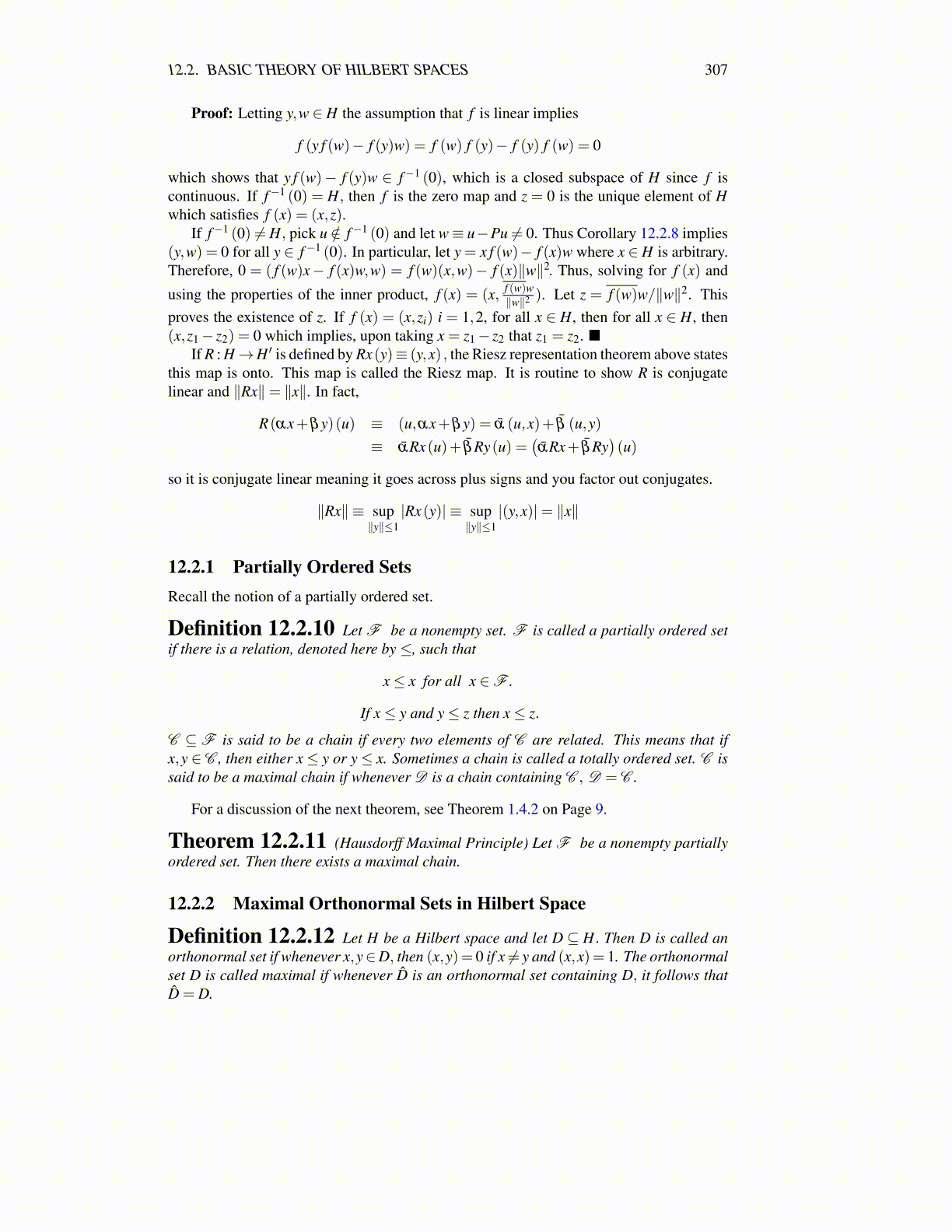
12.2. BASIC THEORY OF HILBERT SPACES 307
Proof: Letting y,w ∈ H the assumption that f is linear implies
f (y f (w)− f (y)w) = f (w) f (y)− f (y) f (w) = 0
which shows that y f (w)− f (y)w ∈ f−1 (0), which is a closed subspace of H since f iscontinuous. If f−1 (0) = H, then f is the zero map and z = 0 is the unique element of Hwhich satisfies f (x) = (x,z).
If f−1 (0) ̸= H, pick u /∈ f−1 (0) and let w≡ u−Pu ̸= 0. Thus Corollary 12.2.8 implies(y,w) = 0 for all y ∈ f−1 (0). In particular, let y = x f (w)− f (x)w where x ∈H is arbitrary.Therefore, 0 = ( f (w)x− f (x)w,w) = f (w)(x,w)− f (x)∥w∥2. Thus, solving for f (x) and
using the properties of the inner product, f (x) = (x, f (w)w∥w∥2 ). Let z = f (w)w/∥w∥2. This
proves the existence of z. If f (x) = (x,zi) i = 1,2, for all x ∈ H, then for all x ∈ H, then(x,z1− z2) = 0 which implies, upon taking x = z1− z2 that z1 = z2. ■
If R : H→H ′ is defined by Rx(y)≡ (y,x) , the Riesz representation theorem above statesthis map is onto. This map is called the Riesz map. It is routine to show R is conjugatelinear and ∥Rx∥= ∥x∥. In fact,
R(αx+βy)(u) ≡ (u,αx+βy) = ᾱ (u,x)+ β̄ (u,y)
≡ ᾱRx(u)+ β̄Ry(u) =(ᾱRx+ β̄Ry
)(u)
so it is conjugate linear meaning it goes across plus signs and you factor out conjugates.
∥Rx∥ ≡ sup∥y∥≤1
|Rx(y)| ≡ sup∥y∥≤1
|(y,x)|= ∥x∥
12.2.1 Partially Ordered SetsRecall the notion of a partially ordered set.
Definition 12.2.10 Let F be a nonempty set. F is called a partially ordered setif there is a relation, denoted here by ≤, such that
x≤ x for all x ∈F .
If x≤ y and y≤ z then x≤ z.
C ⊆F is said to be a chain if every two elements of C are related. This means that ifx,y ∈ C , then either x≤ y or y≤ x. Sometimes a chain is called a totally ordered set. C issaid to be a maximal chain if whenever D is a chain containing C , D = C .
For a discussion of the next theorem, see Theorem 1.4.2 on Page 9.
Theorem 12.2.11 (Hausdorff Maximal Principle) Let F be a nonempty partiallyordered set. Then there exists a maximal chain.
12.2.2 Maximal Orthonormal Sets in Hilbert Space
Definition 12.2.12 Let H be a Hilbert space and let D ⊆ H. Then D is called anorthonormal set if whenever x,y∈D, then (x,y)= 0 if x ̸= y and (x,x)= 1. The orthonormalset D is called maximal if whenever D̂ is an orthonormal set containing D, it follows thatD̂ = D.